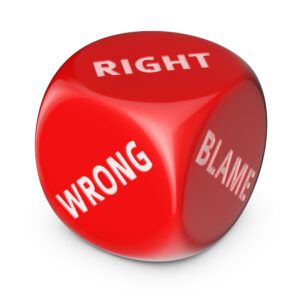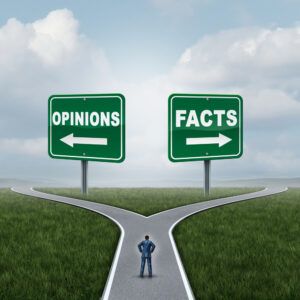Are you using the biopsychosocial model of pain?
In the first few minutes of a recent initial evaluation, my patient burst into tears as she struggled to describe her journey with chronic pain. Has this ever happened to you? She reported visiting doctor after doctor in a desperate attempt to get a diagnosis. She wanted to get off of the opiate medication prescribed by her primary care physician, but her medication use was regarded with suspicion, disgust, and even pity.
“I’m not crazy! This pain exists!” she said.
Her pain and distress were real. Unfortunately, she was putting more effort into convincing the doctor that she was suffering instead of focusing her energy on behaviors that would improve her health. I assume that the doctor saw a distressed woman with chronic pain who was addicted to her medication. I often find that the more distressed a patient is about their chronic pain, the more likely it is that other practitioners may question whether the pain is psychogenic rather than a real experience. Let me take a clear stance on this: it makes complete sense to be frustrated with chronic pain and disappointed that previous efforts to heal pain have not been successful. The blind habit of dismissing chronic pain as “psychogenic”, as some health care professionals do, is a sure sign that they are evaluating stereotypes and not actual patients. There is a world of difference between blaming a patient for their pain and empowering them to take responsibility for the role it plays in their life.
Patient-Blaming and Other Blunders
For many years, a large piece of the chronic pain puzzle was totally missing from patient care. We’ve all heard horror stories about the unjust assumptions made about people with chronic pain as they have struggled in their journeys. Many of these people were called “crazy” by doctors, psychiatrists, psychologists, and even physical therapists. Without physical findings of pathology, people with chronic pain were often blamed for their conditions. The very definition of chronic pain–discomfort that has outlasted the time needed for normal healing–means that the traditional biomedical view is guaranteed to invalidate the suffering of people with chronic pain.
 The biopsychosocial model of pain has failed chronic pain care.
The biopsychosocial model of pain has failed chronic pain care.
What is interesting is that many of stigmas about chronic pain are also used as current criticisms of the biopsychosocial model!
Despite the popularity of the biopsychosocial approach, the average practitioner has no formal training in how to apply it. And the conscientious practitioners who are interested in educating themselves are faced with a huge amount of misinformation in articles, blogs, and even continuing education courses. The critical ingredient that is missing from many of these sources is a comprehensive understanding of the original biopsychosocial model of pain.
The Core Messages of the Biopsychosocial Model of Pain
In 1978, the physician George Engel wrote a famous critique of the biomedical model in medicine (1). He argued that the biomedical model was not improving the quality of patient’s’ health because it oversimplified how “illness” was viewed and treated. Many of his criticisms centered on how standard medical education had failed to train young doctors to assess their patients holistically (I highly recommend Engel’s 1971 paper, “Care and feeding of the medical student: The foundation for professional competence”). His critique led him to formulate the Biopsychosocial Model. In relation to pain, the basic principles of this approach are as follows:
-
- Pain can be rooted in physiological, individual, and contextual causes
-
- Pain may not correspond with tissue pathology, and vice versa
-
- Pathological findings should not be used as a diagnostic crutch, and as practitioners, we need to mindfully monitor ourselves.
-
- Psychosocial factors can affect vulnerability to, severity of, and natural progression of chronic pain
-
- Pain care is a collaboration that influences how patients, practitioners, and scientists interact with one another
-
- The interpersonal relationship between a provider and patient can influence treatment success (a.k.a., the therapeutic bond).
Engel described the biopsychosocial framework as a springboard for taking action. However, he left out several important details on how to make his new model a reality. To be fair, Engel wasn’t an expert in health policy; he was a normal physician who had a vision of what healthcare could look like. As a result, practitioners have spent decades debating the details of the biopsychosocial model of pain. In the same way that practitioner training programs are influenced by various theories and assumptions about patient care, the popular interpretations of the biopsychosocial model have fallen subject to differing opinions on how healthcare can and should be delivered.
The greatest strength of the biopsychosocial model of pain is that it can help explain the large inter-individual differences we see in pain presentations (2). Instead of chalking these differences up to Nature versus Nurture, the biopsychosocial model helps us to understand how pain is affected by:
-
- Genetic predispositions
- Past trauma
- Social learning
- Habitual movements
- Thoughts and feelings
A biopsychosocial perspective also tells us how a patient interprets their pain. Unhelpful interpretations can lead to mood problems like anxiety and depression, as well as unhelpful coping strategies that limit a person’s potential to heal.
5 Misconceptions about the BPS Model
Misconception #1- If pain isn’t physical, it must be “all in the head”
This is a surprisingly common criticism that treats the biopsychosocial model of pain as a continuation of the biomedical model. Under the biomedical perspective, objective pathology is the only way that disease can be defined. If a person with chronic pain shows no evidence of tissue or nervous system changes, practitioners assume the pain is caused by psychological factors. In contrast, the biopsychosocial model recognizes that pain happens to a person, and people have emotions, thoughts, and social interactions that affect how their biology is expressed. It shifts the conversation from black-and-white prognosis to a more colorful, comprehensive approach. This perspective recognizes that symptoms can be amplified or reduced based on factors that patients can actually control; nutrition, activity, stress reduction, and coping skills amongst them.
 The idea that psychological states can impact biology is not a new idea. One of the clearest examples of this idea is the Glucocorticoid Cascade Hypothesis (3). Emotional and physical stress cause the adrenal cortex to produce the glucocortiocoid hormone, cortisol. With repeated stress, an overproduction of cortisol causes various biochemical and metabolic changes that can lead to dendrite atrophy and neuron death in the hippocampus. The hippocampus plays an important role in working memory and in the creation of autobiographical memory, therefore neuron death may cause problems with thinking and reasoning in relation to the self. This is a major hypothesis in how post-traumatic stress disorder changes the brain. Fortunately, these changes can be reversed with techniques such as mindfulness-based stress reduction. This research is a great example of the biopsychosocial model of pain in action.
The idea that psychological states can impact biology is not a new idea. One of the clearest examples of this idea is the Glucocorticoid Cascade Hypothesis (3). Emotional and physical stress cause the adrenal cortex to produce the glucocortiocoid hormone, cortisol. With repeated stress, an overproduction of cortisol causes various biochemical and metabolic changes that can lead to dendrite atrophy and neuron death in the hippocampus. The hippocampus plays an important role in working memory and in the creation of autobiographical memory, therefore neuron death may cause problems with thinking and reasoning in relation to the self. This is a major hypothesis in how post-traumatic stress disorder changes the brain. Fortunately, these changes can be reversed with techniques such as mindfulness-based stress reduction. This research is a great example of the biopsychosocial model of pain in action.
This either/or mode of thinking about the relationship between mind and body has been a part of scientific discourse since Rene Descartes. We are discovering that simple solutions such as these are not supported by research. For example, millions of dollars were put into research to identify THE gene for schizophrenia. It turns out that schizophrenia, like many clinical conditions, is influenced by multiple genes and their epigenetic interactions. The point is that a two-factor model (biological versus psychological) cannot explain the clinical realities we face as pain practitioners. The biopsychosocial model of pain moves away from simple biomedical explanations and acknowledges that people exist in a larger context. Biology has embraced complexity, and it is time for us to follow suit.
Misconception # 2. Physical findings prove that psychosocial factors aren’t at play
This criticism is the flip side of Misconception #1. It is based on the idea that identifying a structural abnormality or getting a positive test result that could account for pain means that psychosocial factors are no longer important. Why bother with psychosocial factors when you already have a tidy test result? The biopsychosocial model of pain doesn’t require each part of the model to play an equally important role for everyone.
 Practitioners may be uncomfortable with equating a subjective experience to the objective measures of pain. If we refer strictly to research, it’s clear that there is no a priori reason to put faith in one outcome measure over another (4). When I track a patient’s functional performance before and after treatment, I know that there are many factors that can bias the results. Is my patient willing and motivated to fully engage in the test? Do they have the experience and physical capacity to perform optimally? Did they eat a proper breakfast that morning? (This is a great example of an opportunity to integrate the biopsychosocial perspective with biomechanics!) But the more important issue here relates to how weigh these different types of information. This is an ongoing debate that should be based on empirical evidence. As of now, the evidence favors the biopsychosocial model of pain.
Practitioners may be uncomfortable with equating a subjective experience to the objective measures of pain. If we refer strictly to research, it’s clear that there is no a priori reason to put faith in one outcome measure over another (4). When I track a patient’s functional performance before and after treatment, I know that there are many factors that can bias the results. Is my patient willing and motivated to fully engage in the test? Do they have the experience and physical capacity to perform optimally? Did they eat a proper breakfast that morning? (This is a great example of an opportunity to integrate the biopsychosocial perspective with biomechanics!) But the more important issue here relates to how weigh these different types of information. This is an ongoing debate that should be based on empirical evidence. As of now, the evidence favors the biopsychosocial model of pain.
Misconception #3. A patient’s opinion trumps objective findings
Due to professional training and experience, we tend to value more objective ways to assess and treat people who struggle with pain. This may be as simple as using an algometer to track sensitivity to pressure pain or by administering a standardized diagnostic interview, or as complex as evaluating levels of inflammatory cytokines in cerebrospinal fluid. The truth of the matter is that pain, by definition, is a subjective experience. The success of our assessments and treatments is determined by that subjective experience. This principle is so important that a task force from the International Association for the Study of Pain has made a public statement against the use of “objective” measures in diagnosing pain (5).

When moving toward the biopsychosocial model of pain, it is our responsibility to ask the patient to educate us about their journey with chronic pain. This information is an important piece of their pain puzzle. We do not suggest coddling the patient, however, we do encourage having open dialogue with the people who entrust us with their health. Likewise, patients have the right to receive clear explanations of the logic behind every intervention so that they can knowledgably accept or refuse treatment.
Misconception #4. Pathologizing health
I have built my career around helping patients heal themselves naturally, and I understand the concerns about pathologizing. I often find that a diagnosis can do more harm than good because it can cause a person to worry about their symptoms. We know that people’s emotions have an impact on both the intensity and duration of their pain, and diagnosis may trigger more fear and anxiety than the patient had to begin with. The overmedicalizing of chronic pain has created a huge nocebo effect for so many people who struggle to improve the quality of their health.
 People like to cite the finding that 49% of people in one study met the criteria for some kind of biopsychosocial dysfunction based on how they answered standardized questionnaires. The authors implied that this percentage is artificially large because our definitions of biopsychosocial problems are too broad. Large portions of the population who struggle with depression or histories of trauma lead normal lives because they have learned to cope with their thoughts and feelings in a healthy way.
People like to cite the finding that 49% of people in one study met the criteria for some kind of biopsychosocial dysfunction based on how they answered standardized questionnaires. The authors implied that this percentage is artificially large because our definitions of biopsychosocial problems are too broad. Large portions of the population who struggle with depression or histories of trauma lead normal lives because they have learned to cope with their thoughts and feelings in a healthy way.
But this type of criticism makes a lot of assumptions:
-
- It assumes that a questionnaires definition of clinical severity is the same as a formal diagnosis.
-
- It assumes that those questionnaires can tell us who is normal and who isn’t normal.
- It assumes diagnostic systems like the Diagnostic and Statistical Manual (DSM-V) require that a person is distressed about their problem and that it prevents them from living their lives.
We need to keep the context in mind!
In reality, people develop many strengths throughout their lives that make them more resilient to stress, traumatic events, and disease.
Even if someone has low back pain that always gets worse when they are stressed out from work, they have a toolbox of coping skills–such as regular exercise, reframing negative thoughts, and mindfulness meditation–that keeps stress and pain in check. Helping a patient discover the biopsychosocial strategies that are most helpful to them is a great way to enhance their resilience.
Misconception #5. Taking a Stand: Biomedical or Biopsychosocial?
Embracing a biopsychosocial approach doesn’t make the biomedical model invalid. But research has clearly shown that spinal MRIs are not Magic 8-Balls for predicting the future of pain. Inflammation is not the ultimate biomarker we were taught it was, and every day, millions of adolescents with poor postures are playing Halo 3 for six hours at a time without pain. In the same vein, the biomedical model has not uncovered the root cause of chronic pain, why it changes over time, what makes one person more likely to develop pain than another, or how it can be “cured” for good.
In a head to head comparison, the biopsychosocial model of pain outperforms the old approach. For example, ‘pain catastrophizing’–which doctors once considered a symptom of a “problem” patient–predicts poor post-surgery outcomes in pain patients, mood problems, and higher rates of disability better than any medical test available. Researchers at Stanford have found that catastrophizing even changes brain anatomy (6). Fortunately, we also know that cognitive behavioral therapy, a treatment approach that targets catastrophizing, can reverse pain-related brain changes within 6 months (7). As practitioners, we should be asking ourselves how we can take advantage of such a powerful framework.
How to Enrich Your Practice with the Biopsychosocial Model
The decision to move toward a biopsychosocial approach for healing pain may seem challenging if you don’t know where to start. The small handful of programs that provide formal biopsychosocial training focus on a core set of skills to direct patient assessment and treatment (8). While every one of these skills may not apply to your practice, I guarantee that developing a few of these core competencies will enrich your practice:
-
- Biopsychosocial clinical reasoning
-
- Multidisciplinary pain care adapted to specific populations
-
- Roles of Psychosocial, socioeconomic, ethnicity, and gender factors
-
- Cultural competence/Cross-cultural factors
-
- Stress
-
- Understanding illness experience
-
- Communicating health information to patients and their families
-
- Facilitating motivation/behavioral change/movement
-
- Modern culture of healthcare
The biopsychosocial perspective can transform your practice if you understand what the framework really means. The first step is to become aware of how biopsychosocial factors affect interactions with your patients. As you become more comfortable with weaving these factors into your treatment plans, the biopsychosocial approach will become a powerful foundation for your practice.
Did we leave out any misconceptions?
Let us know and connect with us on our Facebook page!
[Also read: Is the Biopsychosocial Model a Cure for the Opioid Epidemic]



